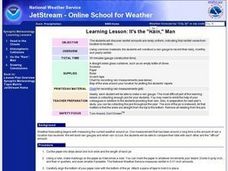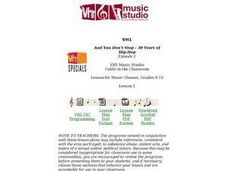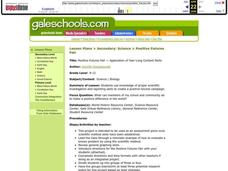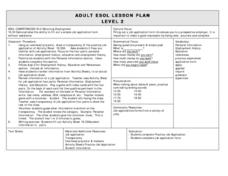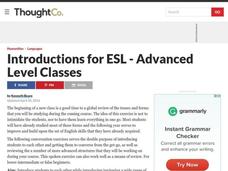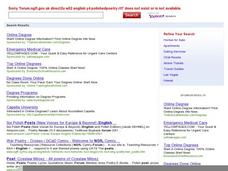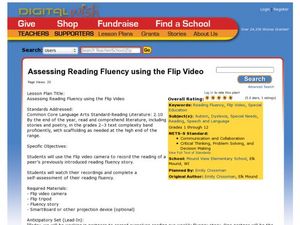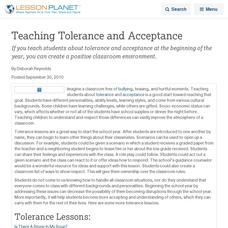Curated OER
Learning Lesson: How To Make A Rain Gauge
Students discover that rainfall amounts are rarely uniform which means the amount of rain is different from location to location. They construct their own rain gauge using everyday materials.
Curated OER
And You Don't Stop-30 Years of Hip-hop
High schoolers identify the musical genre of Hip-Hop and make a connection with other styles of music. A time line of musical styles is developed and discussed.
Curated OER
Abraham Lincoln's Young Years
Third graders explore the life of Abraham Lincoln. They read and discuss the life and times of Abraham Lincoln. Students write three sentences about an important part of the life of Abraham Lincoln. They edit and revise their sentences.
Curated OER
Farming: Seasons on a Wheat Farm (Lesson 4)
Young scholars explain the seasons on a wheat farm. They identify the uses of a grain elevator as well. They use a dry erase board to illustrate the seasons and the grain elevator in operation.
Curated OER
Learning Lesson: Analyzing a Weather Map
Pupils use weather maps to locate warm and cold fronts. They discover the different types of weather associated with these fronts. They also observe the weather in their local area.
Curated OER
Positive Futures Fair - Application of Year-Long Content Skills
High schoolers demonstrate the knowledge of proper scientific investigation and reporting skills. They decide how to make a positive difference in the world using these skills.
Curated OER
ADULT ESOL LESSON PLAN--Level 2--Obtaining Employment
Students, after reviewing the vocabulary terms on the board, examine how to fill out a job application form with a prospective employer. After seeing one model for the students, they practice one and then fill out an actual job...
Curated OER
Gyotaku Lesson Plan
Students examine and discuss the history and process of Gyotaku, or fish prints. They view images of Gyotaku, create a fish print, and write a haiku.
Curated OER
Persuasive Writing Lesson Plan: Dress Codes
Students examine the pros and cons of the implementation of public policy matters and the specific issue of dress codes. They develop a list of pros and cons of a school dress code, examine and discuss a local editorial newspaper page,...
Curated OER
Introductory Lesson for Advanced Level Classes
High schoolers participate in conversation exercises to introduce themselves and to review verb tenses. They interview each other and share conversations.
Curated OER
Teaching With Documents Lesson Plan:Launching the New U.S. Navy
Pupils demonstrate understanding of the issues related to the creation and ratification of the United States Constitution and the new Government it established.
NEED Project
Calibrating Thermometers
Engage young scientists in the upper-elementary and middle school grades with this collection of simple experiments. Whether you're teaching about heat transfer, density, or potential energy this resource has a lab for you.
Messenger Education
Design Challenge: How to Keep Items Cool in Boiling Water
Keeping items cool in boiling water... what? This engaging activity challenges high school learners to build a container that keeps butter in a solid state when placing the container in boiling water. Groups use previous knowledge and...
K20 LEARN
Who Am I? Creating And Editing Descriptive Writing
With descriptive writing, the pleasure is in the details. Young writers learn how to add sensory details to a paragraph about themselves. They read a short paragraph and identify the sensory details used. After revising their draft...
Center for Civic Education
Responsibility and the U.S. Constitution
When are responsibilities freely chosen, and when have they actually been imposed on us? Here you'll find a unique way to frame your class discussion on civic duty and responsibilities inherent in the United States Constitution.
Curated OER
Polished Poetry: Strange Zoo
Fourth graders use an online word list editor and software to create opening lines for a poem. They select and edit these into a complete, polished poem about an animal. They investigate parts of speech and alliteration.
Curated OER
Assessing Reading Fluency Using the Flip Video
Utilizing a video camera, learners will read a story while being recorded. Later, they analyze the footage. After identifying their strengths and weaknesses with the teacher, they discuss reading fluency techniques. Adaptation: Instead...
Broward County Schools
ABC’s of Bullying Prevention
What is the problem? Why should I care? What can I do about it? These three questions are at the heart of a program designed to lead young people to understand that the way to prevent bullying is for their Attitude and Behavior to Change...
Howard Hughes Medical Institute
Population Dynamics
Will human population growth always be exponential, or will we find a limiting factor we can't avoid? Young scientists learn about both exponential and logistic growth models in various animal populations. They use case studies to...
Steppenwolf Arts Exchange
Fahrenheit 451: Study Guide
Here's a must-have packet for your curriculum library. If you are interested in Fahrenheit 451, if you are interested in Ray Bradbury, if you are interested in censorship, if you interested in programs that make a difference, then...
Visa
Nothing But Net: Understanding Your Take Home Pay
Introduce your young adults to the important understanding that the money they receive from their paychecks is a net amount as a result of deductions from taxes. Other topics covered include federal, state, Medicare and social...
Smithsonian Institution
POWs
Why did Vietnam POWs and their families receive more media attention than POWs in previous wars? To answer this question, class members view artifacts, read articles, and engage in class discussion. Individuals then assume the...
Curated OER
Using a Calendar
Students explore a calendar. In this calendar activity, students sequence the 12 months of the year using posters with guidance from the teacher. Students recite the days of the week.
Curated OER
Teaching Tolerance and Acceptance
If you teach students about tolerance and acceptance at the beginning of the year, you can create a positive classroom environment.
